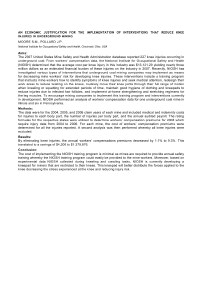Mining Publication: An Economic Justification for the Implementation of Interventions that Reduce Knee Injuries in Underground Mining
Original creation date: September 2010
Authors: SM Moore, JP Pollard
NIOSHTIC2 Number: 20038059
Seventh International Scientific Conference on Prevention of Work-Related Musculoskeletal Disorders (PREMUS 2010), August 29 - September 2, 2010 Angers, France. Rome, Italy: International Commission on Occupational Health (ICOH), 2010 Aug-Sep; :413
The 2007 United States Mine Safety and Health Administration database reported 227 knee injuries occurring in underground coal. From workers’ compensation data, the National Institute for Occupational Safety and Health (NIOSH) determined that the average cost per knee injury in this industry was $13,121.29 yielding nearly three million dollars as an estimated financial burden of these injuries on the industry in 2007. Recently, NIOSH has investigated various types of interventions that underground coal mining companies may implement as means for decreasing mine workers’ risk for developing knee injuries. These interventions include a training program that instructs mine workers how to identify symptoms of knee injuries and seek medical attention, redesign their work areas to reduce twisting on the knees, routinely move their knee joints through their full range of motion when kneeling or squatting for extended periods of time, maintain good hygiene of clothing and kneepads to reduce injuries due to infected hair follicles, and implement at-home strengthening and stretching regimens for the leg muscles. To encourage mining companies to implement this training program and interventions currently in development, NIOSH performed an analysis of workers’ compensation data for one underground coal mine in Illinois and six in Pennsylvania. Methods: The data were for the 2004, 2005, and 2006 claim years of each mine and included medical and indemnity costs for injuries to each body part, the number of injuries per body part, and the annual audited payroll. The rating formulas for the respective states were utilized to determine workers’ compensation premiums for 2008 which require injury data from 2004 to 2006. For each mine, the cost of workers’ compensation premiums were determined for all the injuries reported. A second analysis was then performed whereby all knee injuries were excluded.

NIOSHTIC2 Number: 20038059
Seventh International Scientific Conference on Prevention of Work-Related Musculoskeletal Disorders (PREMUS 2010), August 29 - September 2, 2010 Angers, France. Rome, Italy: International Commission on Occupational Health (ICOH), 2010 Aug-Sep; :413
- An Analysis of the Potential of Roof Screening to Reduce Workers' Compensation Costs
- Demands on the Knee During Kneeling and Squatting Activities Common to Low-seam Mining
- Economic Consequences of Mining Injuries
- Evidence that Reducing Knee Injuries in Underground Mining may have a Substantial Impact on Mine Company Finances
- Keeping Knees Healthy in Restricted Work Spaces: Applications in Low-Seam Mining
- Potential of Roof Screening to Reduce Workers' Compensation Cost
- Pressure Distribution on the Anatomic Landmarks of the Knee and the Effect of Kneepads
- Pressures Applied to Anatomical Landmarks of the Knee While in Kneeling Postures
- Reduced Workers� Compensation Costs With Roof Screening
- Thigh-Calf and Heel-Gluteus Contact Forces in High Flexion: Experimental Results